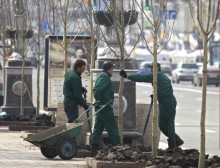The authorities promised to plant red horse-chestnuts, but the trees have broken into white blossom, prompting environmentalists and civic activists to suspect the city officials of engaging in a botanical fraud. They say that the trees, allegedly belonging to the Brioti variety, brought from as far as Italy and planted on Khreshchatyk in April, are really just horse-chestnuts, a common sight in Kyiv. The activists list several grounds for their suspicions. Firstly, the young chestnut trees have broken into white blossom instead of the Italian variety’s red. Secondly, the leaves on the trees are mostly seven-lobed instead of five-lobed.
But what the ecologists emphasize as most important is the young chestnuts already withering and displaying signs of infestation by the horse-chestnut leaf miner, while the Brioti variety is resistant to this pest. Therefore, the experts say, this substitution was a deliberate action aimed at creating need to plant new trees in a year or two.
“In fact, what we are seeing on Khreshchatyk is someone stealing public money. It is a clear example of the peculiar Ukrainian way to do public spending,” an activist of the National Ecological Center of Ukraine Oleksandr Sokolenko says. “They planted limes which do not grow along the roads, then realized their error and uprooted the trees, only to plant the chestnut trees in their place which will wither as well. Every tree cost 5,500 hryvnias, as their own press release stated. This is our money which they are just digging into Khreshchatyk soil.”
Let us recall that it is not the first time for the capital’s main street to have trees planted on it. Back in 2007, the authorities replaced chestnuts with elite limes bought in Germany, but went on to replace the limes with... marigolds. On the eve of the soccer Euro-2012, the city uprooted the surviving chestnuts from Khreshchatyk, promising to plant a new pest-resistant variety later. The civic activists are ready to appeal to the prosecutor’s office to force the officials into fulfilling of their promise.
“I have no illusions about promptness of the prosecutor’s office response. Still, I expect that there will be some sort of political pressure on the municipal authorities from the Kyivites, and the citizenry will demand that the people who promised to replace those chestnuts that had been cut before the Euro finally act on their promise. They did not do it the first time, but they could repair it somewhat by acting on the second occasion,” an activist of the Save Old Kyiv movement Ihor Lutsenko says.
The capital’s administration refused to comment on the new Khreshchatyk chestnuts’ provenance and health status, redirecting our request for information to the municipal utility. In its turn, the municipal greenery maintenance company of Kyiv’s Shevchenkivsky district said it would check on the trees provenance, calling on expert botanists. Should an illicit substitution be detected, the trees will be replaced by the grower under warranty, the utility has promised. However, for now, the authorities are confident that the re-planting will never happen, because the planted chestnuts are true Italian specimens.
“For now, our stance is it is the Brioti chestnuts which we have planted. We have documents to prove this, but have requested further information and expert examination to confirm it yet again,” the deputy director of the Shevchenkivsky district utility Serhii Kruts remarks.
Meanwhile, botanists have already concluded that most trees which have been planted on Khreshchatyk are of common horse-chestnut species.
“I walked along Khreshchatyk yesterday and noticed about 250 chestnuts there which have been planted over recent years. Of these, about 215 are familiar trees that bloom white,” head of the Department of Dendrology and Park Design at the Hryshko Botanical Garden Yurii Klymenko recounts. “I expect that the Khreshchatyk chestnuts will be completely infested by the horse-chestnut leaf miner and lose all their leaves as soon as mid-summer.”
Meanwhile, other botanists contend that the young trees will adapt in a few years, and we will see them to be of the Brioti variety, and not horse-chestnuts. The easiest way to do this is by looking at the fruit of the chestnut: any smooth, barb-free fruit would belong to a Brioti tree. At the same time, it can blossom white, too, if stressed, assures the director of the Fomin Botanical Garden Oleksandr Senchylo.
“These plants are of hybrid origin, and hybrid genes can uncouple. Accordingly, the variability of these features is extremely large,” he says. “Over the years and with varying fertilizers, the intensity of the color can change.”
However, according to the civic activists, the current state of young chestnuts still falls far short of their price of 5,500 hryvnias per tree. The common specimens would have cost several times less, while the sum listed would be enough to purchase tulip trees, Sokolenko narrates.
It looks likely that the young chestnuts will still have to be replaced after a year or two, the expert says. The best option, in his opinion, would be edible chestnuts which are not just cheaper than the Brioti trees, but more pest-resistant, too.
At the same time, the experts maintain that to get rid of the horse-chestnut leaf miner, there is no need to buy Italian varieties or replace the traditional symbol of Kyiv with its edible relative. The Hryshko Botanical Garden researchers have noticed that even some horse-chestnut trees are becoming pest-resistant in Kyiv. These trees have been listed, provided with GPS coordinates, and will be used to try and produce mothproof offspring.
“Perhaps, spontaneous re-pollination makes the horse-chestnuts’ leaves that escape damage denser. Therefore, the horse-chestnut leaf miner cannot bite through them,” the Hryshko Botanical Garden researcher Oleksii Illienko explains the reasons behind the trees’ evolution. “This gives us good prospects when it comes to the replacement of old damaged plants.”







